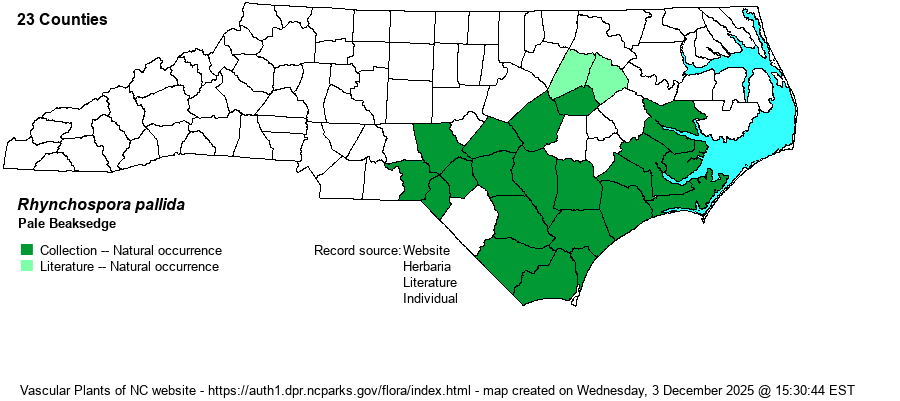| Author | M.A. Curtis | |
| Distribution | Coastal Plain and Sandhills. No records from the northern Coastal Plain.
Coastal Plain, southeastern NY to SC. | |
| Abundance | Uncommon to locally infrequent in well-managed sites. Despite records from 23 counties, and collections from at least 21, this is still named by the NCNHP as a Watch List species. The website editors suggest a State Rank of S3S4, and thus no longer needing a Watch List status. | |
| Habitat | Pitcher-plant seepages, streamhead seepage ecotones, pine savanna-pocosin ecotones. |
| Phenology | Flowering and fruiting July-September. | |
| Identification | Only three NC beaksedges have white female scales, although those of Pale Beaksedge often are tinged with straw color or tan when fresh (and always when old). It differs from R. alba and R. macra by the seeds lacking bristles and by possessing a thickened, bulb-like base of the plant (vs. not thickened in the other two species). As with those species, a sizable stand of the species in flower is quite spectacular. | |
| Taxonomic Comments | None
Members of the genus Rhynchospora -- mainly called beaksedges but also called beakrushes -- are mostly Coastal Plain in distribution and are important members of our longleaf pine savannas, flatwoods, streamheads, depression ponds, Carolina bays, and beaver ponds. They vary from small and wiry to large and coarse. Keys concentrate on features of the achenes (seeds) and the shape and arrangement of the flower clusters (spikelets). The seeds may or not have bristles at their base; bristle number, length, and toothing are critical characters. Size and shape of the seed beaks is also critical. The drawings in Godfrey & Wooten (1979) are extremely helpful. The genus now includes Dichromena, the white-topped sedges. | |
| Other Common Name(s) | None | |
| State Rank | S3 [S3S4] | |
| Global Rank | G3 [G4] | |
| State Status | W1 | |
| US Status | | |
| USACE-agcp | OBL link |
| USACE-emp | OBL link |

